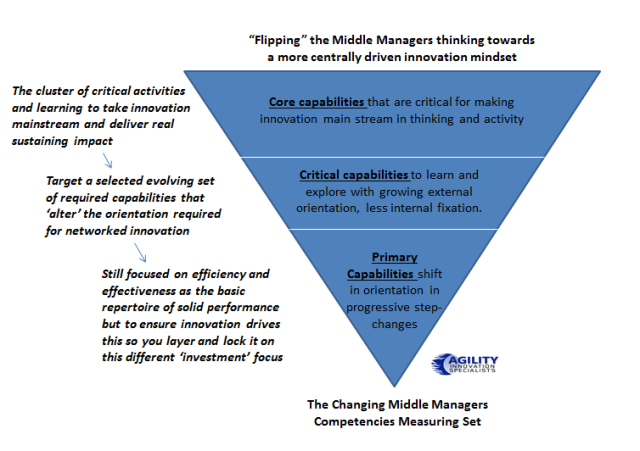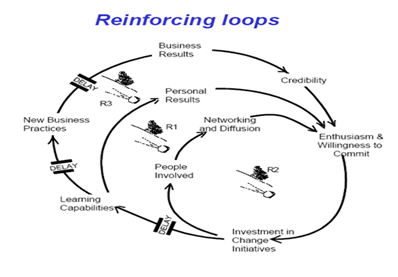It is often claimed that the middle manager seems to the ones holding back innovation. I tend to subscribe to this as well although I feel the circumstances and ‘blame’ might lie elsewhere, more than likely further up the organization. Irrespective of where the culpability lies we do need to change this perception through altering the current dynamics.
The general argument goes that the middle manager is so pressured to focus on the delivery of short-term results that all their efforts are centred far more on delivering ‘just’ an effective organization, that drives out any excess or leeway, reduces variation, constantly dampening down potential risk and uncertainty that is in direct conflict with what innovation required.
By the middle managers obsession with constantly chasing efficiencies alone, there is little ‘slack’ for innovation and new learning. Their measurement is often based on this efficiency and effectiveness emphasis and not on generating innovation.
Resources are often in conflict when it comes to innovation. They are being stretched far more, pushed hard on being involved in multiple tasks and with the prevailing mentality to keep their focus on generating the immediate short-term results.
This not only squashes out opportunity to explore, it is actually squeezing the middle managers ability to build a more flexible, responsive organization. Innovation is in direct ‘tension’ with much that is being undertaken at middle management level.
This does result in working towards a well-tuned and efficient operating system but it seems one that is not capable to allow innovation to move from a collection of ad hoc activities into one that builds progressively that more sustaining innovation structure, establishing a deepening set of capabilities that this requires.
Although organizations claim to be innovative often the very people that we are expecting to manage the ‘dynamics of innovation’ within organizations, the Middle Managers, are seeking the very opposite, doing everything possible to keep the environment as stable and consistent as it can be.
They are taking away the ‘vital essences’ that innovation needs – a fluid, agile, open, diverse and flexible environment and putting consistent constraints and barriers in the way in their pursuit of efficiency and predictable effectiveness.
So how can this change? How can we move the needle and tilt it more towards innovation becoming more central without inflicting a more radical overhaul, one that is unlikely to happen in most existing organizations.
Let’s turn the existing core competencies needed for middle managers on their head and offer a new mix of primary, critical and core capabilities that are the measuring point for the MM’s new core competency set that provides for a clearer innovation focus as essential to master.
1. Core competences need to be changed – we should flip the requirements
We all recognize that the dedicated middle manager holds the organization together. They are often the glue that connects the organization with the leadership and enable the ‘forces’ to flow, yet do they allow this for innovation? In traditional Chinese culture qì (also chi or ch’i) is an active principle forming part of any living thing. Qi is frequently translated as “life energy”, “life force”, or the energy flow “and innovation is the same vital need within organizations.
Let’s flip the thinking

- · Primary becomes the base not the pinnacle. What they do in efficiency and effectiveness remains as their primary capability – you don’t alter this, it is too engrained. This can only change over time and through their inner awareness and recognition that innovation needs to be embedded, alongside the existing ‘fixation’ on efficiency and effectiveness. Don’t try to radically change, make progressive step changes. Efficiency and effectiveness clearly remains the inventory repertoire of solid capabilities so as you set about to build a new platform, based on innovation, it layers and interlocks
- · You target selected critical capabilities to learn and explore. You provide the MM a clarity of the new and emerging critical capabilities they need to build up. These are the capabilities that will provide the greatest impact for competitive advantage, not internal but external in all its orientation.
- · At the top of the pyramid is the core capabilities they need to have. This cluster of capabilities is centred on the critical capabilities to make innovation main stream, to be a daily part of their thinking, their make-up, their intent to ensure happens. These differ according to the role, area of focus and contribution.
2. We need to focus the middle manager on different learning concepts
Peter Senge and his learning organisation concept is helpful in establishing an innovation learning organization. His five main characteristics are system thinking, personal mastery, mental models, a shared vision and team learning. In summary these are:
Systems thinking – the idea would be to introduce a distinct innovation system thinking approach that needs to be in place within their organization. Overtime it will help measure the performance of the organization as a whole, and of its various components, and the organization shifts in the very ground for middle managers has to manage within.
Personal mastery – the commitment by an individual to the process of learning is known as personal mastery, so it is therefore important to develop a culture where personal mastery is practised in daily life, based on clear innovation capabilities and capacities needed to be practised.
Mental models – the assumptions held by individuals and organizations are called mental models and these are seemingly, stuck more in the efficiency and effectiveness ones at present. To become a learning organization, these models must be challenged.
Shared vision – the creation and constant development of a shared vision on innovation and its place within the organisations activities, to make it a core and so create that essential common identity and sense of purpose. This sharing and identity gives real focus and energy for learning and exploring what ‘makes up’ innovation.
Team learning – the accumulation of individual learning constitutes the last aspect, into team learning. The value of the middle manager in bringing people and their contributions together is vital, this is done in innovation efficient and effective ways through increasing experimentation and shared learning to explore and understand the aspects that work and can be honed more.
The emphasis in learning needs a more radical shift in encouraging boundary crossing and openness and seeking out a more networked, relationship environment that draws in increasing external perspectives to compliment the internal knowledge already built up.
3. Then we need to work the innovation learning ‘muscles’ through the three learning loops
Reinforcing loops to strengthen the innovation change management (Peter Senge)
So the middle manager has to begin to think through a new agenda for innovation change and the organization has to ‘fully’ provide the necessary support and structure for them to move towards this (radical) change in their managing within the middle.
The value is the middle becomes our connector for innovation
Middle managers tasks should increasingly become more about performing the role of connectors and facilitators, not the guardians and gatekeepers for the decision makers. Their work should include the encouragement that everyone is engaged in innovation work, for each person to constantly go back and check against this integrated innovation framework to work out their place to relate to this and become aligned.
The middle manager carries through connection and identification. Making sure everyone has a ‘sight-line’ and identification into their contribution for any organizational innovation framework so they stay well-connected and engaged.
Communication and relationships becomes the key. We need to find that new high ground for middle managers to be seen as the real connectors and enablers and not the current view as more often than not the blockers on innovation.
All we need to do is convince the top they need to provide the Innovation framework for this to work and that can come through the form of the Executive Innovation Work Mat no less.
